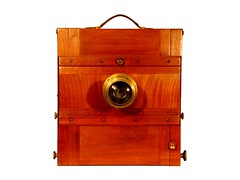Reisekamera
The Reisekamera (eng.: tailboard camera) is a generic subgroup of the wooden plate bellows camera, by some collectors regarded as a distinct type of the view camera, unlike the much lighter and more elegant field camera, but not as cumbersome as the studio camera. The Reisekamera was quite popular in Europe for several decades around 1900. The shape is distinctly square having equally sized front- and rear-panels, both attached to a equally wide base-board. Front and back is connected by an almost non-tapering bellows. The front panel carries the lens plate and the rear panel takes the plate holder which is interchangeable with a focusing screen. Focusing is accomplished by sliding the rear panel along the base plate while observing the image on the screen, usually accomplished by a rack and pinion mechanism. The camera folds flat, after the rear panel is brought forward to the lens panel, by folding the hinged base board up covering the rear panel.
The Reisekamera, believed to have originated in central Europe, influenced by, and to a high degree perfected in Germany from 1860 (re.: Kleffe, Lagner), reached its peak popularity between 1895 and 1914. The general design distinguishes itself, as most notably demonstrated by the consequent description found in Kadlubecks Kamera Katalog, as a wooden camera with a rear baseboard extension "Auszug hinten", as opposed to "Laufboden Kamera" with front struts, generally known as the view camera or field camera having a noticeably smaller front panel

|
| a travel camera's front with Rodenstock lens |
The Reisekamera was originally the portable version of the contemporary Atelier camera, it was collapsible, yet not small, and intended for assignments outside the studio, for architectural work or documentation away from the studio, in homes or museums, but not made for travelling tourists, a feature at first not a practical proposition in photography. The Reisekamera was specifically built for a particular plate size, like 18x24cm and 13x18cm.
The Reisekamera is, regardless of the maker, quite similarly built and of almost standardised design. Generally there are a number of limited movements: at the back, the film plate may be tilted and turned slightly to adjust perspective, and at the front the lens plate may slide vertically and horizontally, without the bellows obstructing the light from the lens reaching the film, due to the non-tapering bellows, as opposed to the field camera where the whole front is free to move as required, including the narrow throated bellows. Usually the base plate is extendible for close-up work and to accommodate various focal length lenses, the double extension feature. Although the camera, when new, rarely was supplied with a shutter, the lens cap usually sufficed, some acquired an add-on shutter of one sort or another. Still, some of the most sophisticated Reisekameras were built with an integral focal plane shutter, a huge mechanism incorporated in the rear panel, only the brass controls visible on either side.
When using the camera a black cloth is a helpful and often necessary requisite to keep stray light out while observing the image on the focusing screen. The focusing screen is replaced by the plate holder when the picture is composed and focused. The lens is capped and the dark slide removed from the plate holder. When all is clear, the cap is removed for the required exposure time and replaced. The dark slide replaced and the plate holder removed and brought to the darkroom for development and copying.
Contents
makers of the Reisekamera
- Eugen Loeber (Dresden)
- Ihagee (Dresden)
- Emil Wünsche (Dresden)
- see also Emil Wünsche Reise-Cameras
- see also Emil Wünsche Schüler-Apparat (student's camera)
- Ernemann (Dresden)
- camera types Globus and Berry
- Richard Wittmann (Dresden)
- Goerz (Berlin)
- Sachs & Co. (Berlin)
- Bentzin (Görlitz)
- Neue Görlitzer Kamerawerke (Görlitz)
- Falz & Werner (Leipzig)
- Annacker (Köln)
- Voigtländer (Braunschweig)
- Deuber & Rau (Nuremberg)
- E. Suter (Basel)
- Georg Faltus (Vienna)
- Rudolf Lechner (Vienna)
- Josef Wanaus (Vienna)
- Felix Neumann (Vienna)
- Georg Joseph (Vienna)
makers of similar cameras, named "travel camera", "chambre de voyage" or else
- Ferdinand Franz Meyer (Dresden)
- J. Lancaster & Son (Birmingham)
- Stereoscopic Co. Ltd. (London)
- Compagnie Française de Photographie
- Derogy (Paris)
- FKD (Kharkov)
Several makers made a different type of Reisekamera or travel camera, with a fixed rear and a smaller sliding front standard that allows shift AND often also tilt movements.
makers of the fixed rear design
- Voigtländer (Braunschweig)
- Josef Vojta (Prague)
- Alfred Werner (Vienna)
makers of more sophisticated field cameras sold as "travel camera", "Reisekamera" or "chambre de voyage"
- Houghtons (London)
- Gaumont (Paris)
- H. Mackenstein (Paris)
- R. A. Goldmann (Vienna)
Links
- Josef Vojta, alternate "Reisekamera" design, at Design und Photo [1]
- Deuber & Rau Reisekamera and "no-name" Reisekamera at Kurt Tauber's [2]
- chambre de voyage, common tailboard architecture, explanation of Continental View type, on Antique Wood Cameras [3]
- chambre de voyage at Sylvain Halgand's [4]
- Reisekamera, unknown maker, at Horst Reimer's [5]
- Wittman Reisekamera, folded, at Fotomuseum [6]